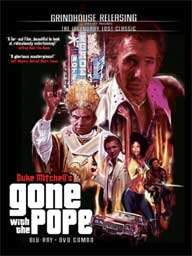 GONE
WITH THE POPE (2010) Blu-ray/DVD combo
GONE
WITH THE POPE (2010) Blu-ray/DVD comboDirector: Duke Mitchell
Grindhouse Releasing
 GONE
WITH THE POPE (2010) Blu-ray/DVD combo
GONE
WITH THE POPE (2010) Blu-ray/DVD comboDuke Mitchell's long unseen and uncompleted follow-up to MASSACRE MAFIA STYLE finally hits Blu-ray and DVD in Grindhouse Releasing's painstaking restoration/reconstruction of GONE WITH THE POPE.

As the feds crack down on casinos, a Chicago syndicate is buying them up as for a steal. Three casinos in Vegas and four in Los Angeles, however, refuse to sell; so John (John Murgia) hits upon the idea to hire a former cellmate Paul (Duke Mitchell, BELA LUGOSI MEETS A BROOKLYN GORILLA) just coming off of a twenty-year sentence to rub out the seven owners for one-hundred thousand dollars. While the sum seems high, John assures his associates that Paul is efficient enough to get the job done but easy enough to get rid of once it is all done. Paul, who has a "Good Samaritan fetish", wants to use the money to help his three buddies who are also up for release and takes steps to ensure his survival. He reconnects with his brother Giorgio (Giorgio Tavolieri) and offers him fifty-thousand dollars to rub out the Vegas owners at the same time he takes out the Los Angeles ones so that the Chicago outfit knows that he has a partner who can squeal on them if they kill him or sell him out. A scenario like that would form the entirety of any other low-budget American (or Italian) exploitation film but we're only half-way through, folks!
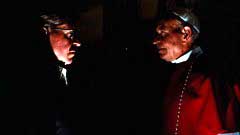 Rather
than being able to feel like less of a kept man to first love widowed Jean (Jeanne
Hibbard) with fifty-thousand dollars in his pocket, Paul borrows Jeanne's yacht
for a cruise with his recently-released buddies Peter (Peter Milo), Luke (Jim
LoBianco), and "The Old Man" (MASSACRE MAFIA STYLE's Lorenzo Dardado),
a cell-mate coming off of a fifty-year stint. The quartet sail across the globe
to Anzio and then onwards to Rome where Paul announces that they are going to
kidnap the Pope and demand in ransom a dollar from every Catholic in the world
(they eventually decide on a half-dollar when they realize that the Catholic
population includes a substantial portion of Asia). They manage to switch the
Pope with "The Old Man" and get him onto the yacht headed to Mexico.
In captivity, the Pope attempts to minister the three men on their inability
to adapt to the world outside prison. Paul resists but Peter and Luke are comforted
by the Pope's words and one of them even experiences a miracle. Will Paul be
betrayed by his own disciples before the Chicago guys can rub him out?
Rather
than being able to feel like less of a kept man to first love widowed Jean (Jeanne
Hibbard) with fifty-thousand dollars in his pocket, Paul borrows Jeanne's yacht
for a cruise with his recently-released buddies Peter (Peter Milo), Luke (Jim
LoBianco), and "The Old Man" (MASSACRE MAFIA STYLE's Lorenzo Dardado),
a cell-mate coming off of a fifty-year stint. The quartet sail across the globe
to Anzio and then onwards to Rome where Paul announces that they are going to
kidnap the Pope and demand in ransom a dollar from every Catholic in the world
(they eventually decide on a half-dollar when they realize that the Catholic
population includes a substantial portion of Asia). They manage to switch the
Pope with "The Old Man" and get him onto the yacht headed to Mexico.
In captivity, the Pope attempts to minister the three men on their inability
to adapt to the world outside prison. Paul resists but Peter and Luke are comforted
by the Pope's words and one of them even experiences a miracle. Will Paul be
betrayed by his own disciples before the Chicago guys can rub him out?

Shot in 1975-1976 but not released until 2009 when it was finished by editor Bob Murawski (SPIDERMAN) over a period of fifteen years between his own editing jobs. Murawski and collaborators Paul Hart and Jody Fedele had to reconstruct the work of original editors Robert Florio (THE DAY AFTER) and Bob Leighton (STUNT ROCK). They had all of the negative and sound reels but no shooting script and only an incomplete rough assembly (missing two entire reels) and a handful of handwritten notes from which to work from. While the film does not quite top Mitchell's MASSACRE MAFIA STYLE, it does convey an amount of growth in the singer-turned-actor-turned-director's storytelling abilities (although he still wants to interrupt scenes with cutaways to other scenes to link ideas rather than allow the viewer to make connections). As with MASSACRE MAFIA STYLE, it feels as if Mitchell was not sure that he would get to make another film so he crammed two movies (the hitman job, kidnapping the Pope, and taking on the Chicago syndicate to avenge Giorgio) into one eight-minute feature. The notion of Peter and Luke being counseled by the captive Pope and finding the light is underdeveloped – or, rather, glossed over with a miracle – although it does lead to a monologue from Paul about the reasons for his own lost faith that are still very relevant (how the church with all of its money and influence focuses on attacking social issues like abortion and divorce instead of genocide and starvation). Mitchell (as Domenico Salvatore Miceli) and his son Jeffrey (a musician in his own right who had played guitar for Suzi Quatro and also appears briefly in the film as a junkie) provide the scoring and songs, including two rollicking rock pieces from Mitchell the younger.
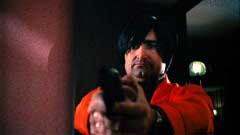 Working
from original 35mm materials left in the care of Jeffrey Mitchell that were
never put through the small-scale theatrical distribution wringer – and
underwent thousands of hours digital dirt and scratch removal as well as attempts
to digitally enhance some out of focus shots – Grindhouse's 1080p24 MPEG-4
AVC 1.78:1 widescreen encode looks stunning with strong colors (particularly
the Vegas neons), crisp detail, and what is very likely a faithful rendering
of the attractive but not always technically perfect photography. Whereas Grindhouse
apparently did not have separate sound elements to do remixes for MASSACRE MAFIA
STYLE, they created the final mix – by Marti Humphrey (THE GRUDGE) –
for GONE WITH THE POPE and were able to provide us with a nice lossless DTS-HD
Master Audio 1.0 mono track as well as a DTS-HD Master Audio 5.1 discrete remix
that gives depth and breadth to the music and effects without attempting to
modernize the film (a lossy Dolby Digital 2.0 stereo downmix is also included).
The 16:9 DVD copy of the film and all extras materials features lossy Dolby
Digital encodes of the 5.1, 2.0, and 1.0 mixes).
Working
from original 35mm materials left in the care of Jeffrey Mitchell that were
never put through the small-scale theatrical distribution wringer – and
underwent thousands of hours digital dirt and scratch removal as well as attempts
to digitally enhance some out of focus shots – Grindhouse's 1080p24 MPEG-4
AVC 1.78:1 widescreen encode looks stunning with strong colors (particularly
the Vegas neons), crisp detail, and what is very likely a faithful rendering
of the attractive but not always technically perfect photography. Whereas Grindhouse
apparently did not have separate sound elements to do remixes for MASSACRE MAFIA
STYLE, they created the final mix – by Marti Humphrey (THE GRUDGE) –
for GONE WITH THE POPE and were able to provide us with a nice lossless DTS-HD
Master Audio 1.0 mono track as well as a DTS-HD Master Audio 5.1 discrete remix
that gives depth and breadth to the music and effects without attempting to
modernize the film (a lossy Dolby Digital 2.0 stereo downmix is also included).
The 16:9 DVD copy of the film and all extras materials features lossy Dolby
Digital encodes of the 5.1, 2.0, and 1.0 mixes).
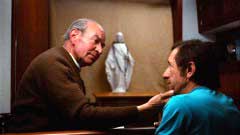
"GONE WITH THE POPE: The Players" documentary (66:52) features the participation of actors Lo Bianco and Mirgia along with original editors Florio and Leighton, cinematographer Santoro (who films some of the other interview), and Mitchell's friend and MASSACRE MAFIA STYLE distributor Matt Cimber. They start off recalling how they all met Mitchell, and the documentary spends a bit too much of its time on Mitchell's background and personality for those who have already seen the featurettes on MASSACRE MAFIA STYLE (although if you haven't, what is given here might be a more succinct overview) and some discussion of the former film (including how it might have caused a rift in Mitchell's relationship with Sinatra over its depiction of Italians) before a scattered account of the making of GONE WITH THE POPE; scattered because it was shot on weekends, in between other jobs (Lo Bianco was a construction worker and had no interest in becoming an actor since he had a family to support), and with some of the participants never meeting one another (Florio and Leighton worked separate day and night shifts in the Mitchell home on the Florio's outdated Moviola, only occasionally working together and struggling to both see the film through the magnifier). Mitchell had the only script (a handwritten one that differs from the printed on in the PDF section) and there was no record of the shots so the editors had no idea which takes were usable. Most of the participants can explain why the film fizzled out and simply lost contact with Mitchell, but Murgia suggests that it was a matter of money. He executive produced Mitchell's unaired Jimmy Durante special (included on the MASSACRE MAFIA STYLE disc) which the director may have anticipated would raise more money to finish the film, but Murgia thinks they would have had a better chance of finishing the film had they not mounted the Durante project.
 "Shooting
POPE" featurette (23:18) features Santoro discussing the experience of
shooting the film, from hand-holding the forty-five pound Arri camera (which
had to be blimped since it was not intended for sync sound shooting), old lenses,
a limited lighting kit, and sometimes lighting, operating the camera, focusing,
and recording sound at the same time. More than just a technical discussion,
Santoro relates Mitchell's working process and how the staging of the scenes
was often improvised from what Mitchell had sketched out for himself, and how
new scenes seemed to arise as locations became available. In "Restoring
POPE" featurette (3:14), Santoro talks to an offscreen Murawski about how
they finally finished restoring the film after a number of years in between
the first discussions, how the new technology allowed them to color correct
the mismatched short ends, clean up scratches, and manage grain, as well as
doing a film out and making 35mm prints.
"Shooting
POPE" featurette (23:18) features Santoro discussing the experience of
shooting the film, from hand-holding the forty-five pound Arri camera (which
had to be blimped since it was not intended for sync sound shooting), old lenses,
a limited lighting kit, and sometimes lighting, operating the camera, focusing,
and recording sound at the same time. More than just a technical discussion,
Santoro relates Mitchell's working process and how the staging of the scenes
was often improvised from what Mitchell had sketched out for himself, and how
new scenes seemed to arise as locations became available. In "Restoring
POPE" featurette (3:14), Santoro talks to an offscreen Murawski about how
they finally finished restoring the film after a number of years in between
the first discussions, how the new technology allowed them to color correct
the mismatched short ends, clean up scratches, and manage grain, as well as
doing a film out and making 35mm prints.
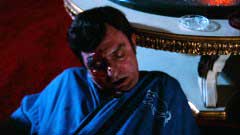
The disc also includes seven deleted scenes (17:18) – some without
sound – including an extended conversation with the young prisoner on
Paul's way out of prison, some bits where he reconnects with old friends on
the outside, and a scene where Peter overcomes his fear of water to save a kid
in Mexico. The outtakes (12:41) include takes botched by blown lines and airplanes,
as well as Mitchell feeding lines to the actors, directing them while he is
onscreen (often just telling the actor to say a line again rather than cutting
and doing another take). Mitchell apparently thought of also marketing the film
to porn filmmakers/distributors the Mitchell Brothers (BEHIND THE GREEN DOOR)
and intended to shoot hardcore inserts. Cinematographer Peter Santoro appears
in a featurette (6:11) in which he reveals that what Mitchell referred to as
an insert turned out to be a full sequence of Paul meeting a girl and having
sex with her. The shoot ended up a fiasco with the hired girl in tears (a comic
interlude with a naked "Fat Woman" that did make the final cut seems
even more humiliating) and Mitchell not being able to rise to the occasion,
and the sequence – which has no hardcore footage – has been pieced
together into a rough assembly. While the scene itself is of little interest,
the story around the shoot might have made an interesting addition to the section
of MASSACRE MAFIA STYLE in which Mitchell's Don goes straight by getting into
porn production.
 The "Frankie Carr and the Nov-Elites: Live in Vegas" performance (8:15)
consists of the raw footage from which the scenes featuring the club act in
the film were constructed. The "Hollywood World Premiere" featurette
(20:48) covers the film's premiere at the Egyptian Theatre (in a double bill
with MASSACRE MAFIA STYLE) and a Q&A with Santoro, Murgia, Lo Bianco, Jeffrey
Mitchell, as well as Grindhouse's Sage Stallone and Murawski (Blue Underground's
Bill Lustig is also seen in attendance). In addition to the newly-created trailer
(2:00) and still galleries (stills from the production and the 2010 theatrical
release), the disc includes two Easter Eggs – footage from the 2010 screening
at the New Beverly Cinema and John Murgia's reactions to seeing the film for
the first time – as well as a trailer for BELA LUGOSI MEETS A BROOKLYN
GORILLA on Mitchell's filmography.
The "Frankie Carr and the Nov-Elites: Live in Vegas" performance (8:15)
consists of the raw footage from which the scenes featuring the club act in
the film were constructed. The "Hollywood World Premiere" featurette
(20:48) covers the film's premiere at the Egyptian Theatre (in a double bill
with MASSACRE MAFIA STYLE) and a Q&A with Santoro, Murgia, Lo Bianco, Jeffrey
Mitchell, as well as Grindhouse's Sage Stallone and Murawski (Blue Underground's
Bill Lustig is also seen in attendance). In addition to the newly-created trailer
(2:00) and still galleries (stills from the production and the 2010 theatrical
release), the disc includes two Easter Eggs – footage from the 2010 screening
at the New Beverly Cinema and John Murgia's reactions to seeing the film for
the first time – as well as a trailer for BELA LUGOSI MEETS A BROOKLYN
GORILLA on Mitchell's filmography.
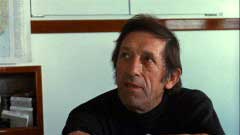 The
DVD-ROM content consists of two PDF files. The first is the film's forty-nine
page screenplay preceded by a two-page hand-written treatment on canary notepad
paper. The original scenario lacks the hit on the seven casino owners and focuses
on the four convicts attempting to adapt to society after so long in prison
before hitting upon the plan. They change their names to those of the saints
as part of the plan and end up, having acquired knowledge from the pope, saints
of a kind who find their place in the world teaching the power of faith. The
remaining pages are handwritten notes on the content and changes made to each
reel of the final film. The second PDF file is a twenty-page paper by John Draner
on the restoration of the film (in which we also learn that the camera negative,
preservation elements and all of the Digital Intermediate data files have been
archived) and to what degree it is considered a restoration given the creative
choices Murawski had to make to reconstruct it while trying to remain true to
the spirit of the film and not smooth over its stylistic and technical shortcomings.
Also included is a fold-out poster with a portrait of Mitchell, chapter selections,
and a two-page essay by John Skipp on the reverse. (Eric
Cotenas)
The
DVD-ROM content consists of two PDF files. The first is the film's forty-nine
page screenplay preceded by a two-page hand-written treatment on canary notepad
paper. The original scenario lacks the hit on the seven casino owners and focuses
on the four convicts attempting to adapt to society after so long in prison
before hitting upon the plan. They change their names to those of the saints
as part of the plan and end up, having acquired knowledge from the pope, saints
of a kind who find their place in the world teaching the power of faith. The
remaining pages are handwritten notes on the content and changes made to each
reel of the final film. The second PDF file is a twenty-page paper by John Draner
on the restoration of the film (in which we also learn that the camera negative,
preservation elements and all of the Digital Intermediate data files have been
archived) and to what degree it is considered a restoration given the creative
choices Murawski had to make to reconstruct it while trying to remain true to
the spirit of the film and not smooth over its stylistic and technical shortcomings.
Also included is a fold-out poster with a portrait of Mitchell, chapter selections,
and a two-page essay by John Skipp on the reverse. (Eric
Cotenas)